Properties of the Top Quark
Abstract
:1. Introduction
2. Accessing Top Quark Properties
Production of Top Quarks
3. Top Quark Properties in Production
3.1. Measurements of Angular Correlations
3.2. Search for Lorentz Invariance Violation
3.3. Top Quark Mass
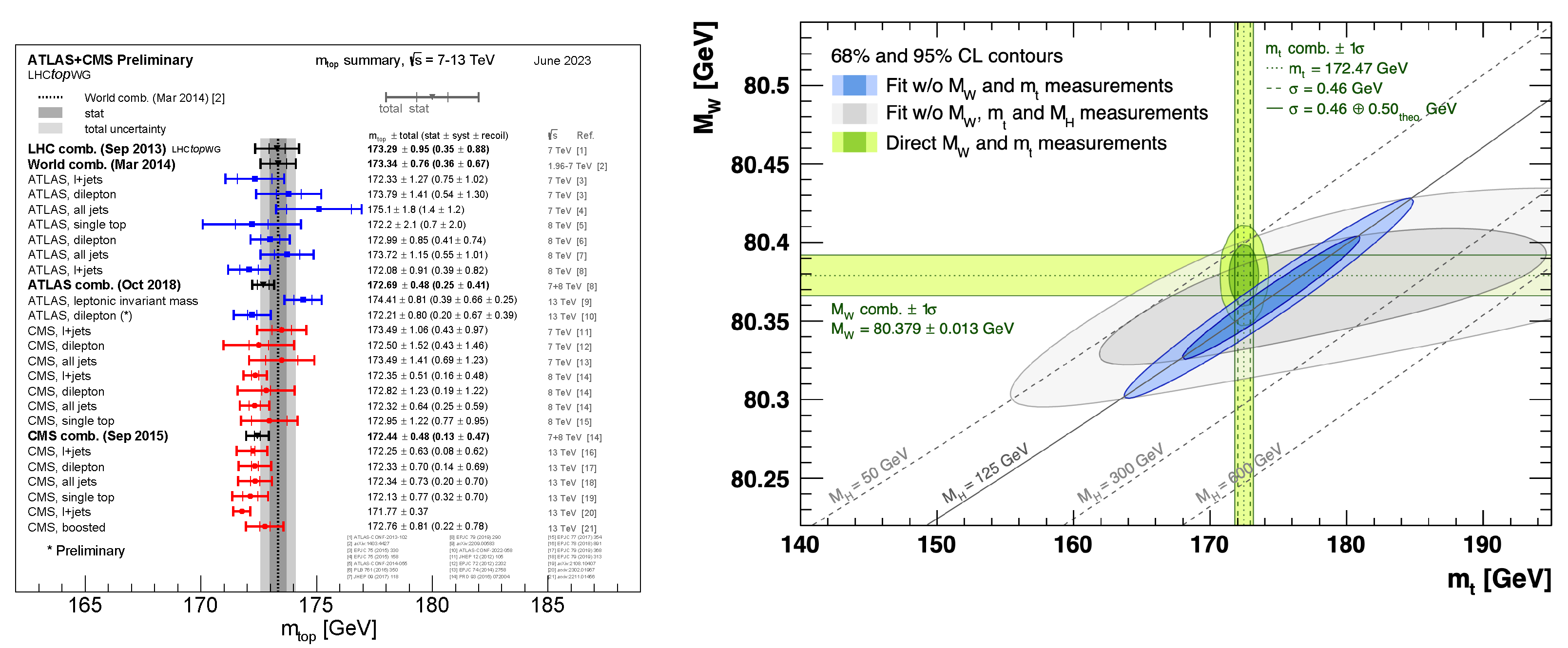
3.4. Top Quark Yukawa Coupling
3.5. Top Quark Width
3.6. Top Quark Properties in Associated Production

4. Summary
Funding
Data Availability Statement
Conflicts of Interest
References
- Abe, F. et al. [CDF Collaboration] Observation of Top Quark Production in pp Collisions with the Collider Detector at Fermilab. Phys. Rev. Lett. 1995, 74, 2626–2631. [Google Scholar] [CrossRef] [PubMed]
- Abachi, S. et al. [D0 Collaboration] Observation of the Top Quark. Phys. Rev. Lett. 1995, 74, 2632–2637. [Google Scholar] [CrossRef]
- Aad, G.; Abajyan, T.; Abbott, B.; Abdallah, J.; Abdel Khalek, S.; Abdelalim, A.A.; Abdinov, O.; Aben, R.; Abi, B.; Abolins, M.; et al. Observation of a new particle in the search for the Standard Model Higgs boson with the ATLAS detector at the LHC. Phys. Lett. B 2012, 716, 1–29. [Google Scholar] [CrossRef]
- Chatrchyan, S.; Khachatryan, V.; Sirunyan, A.M.; Tumasyan, A.; Adam, W.; Aguilo, E.; Bergauer, T.; Dragicevic, M.; Erö, J.; Fabjan, C.; et al. Observation of a new boson at a mass of 125 GeV with the CMS experiment at the LHC. Phys. Lett. B 2012, 716, 30–61. [Google Scholar] [CrossRef]
- de Blas, J.; Pierini, M.; Reina, L.; Silvestrini, L. Impact of the recent measurements of the top-quark and W-boson masses on electroweak precision fits. Phys. Rev. Lett. 2022, 129, 271801. [Google Scholar] [CrossRef] [PubMed]
- de Blas, J.; Ciuchini, M.; Franco, E.; Goncalves, A.; Mishima, S.; Pierini, M.; Reina, L.; Silvestrini, L. Global analysis of electroweak data in the Standard Model. Phys. Rev. D 2022, 106, 033003. [Google Scholar] [CrossRef]
- de Blas, J.; Chowdhury, D.; Ciuchini, M.; Coutinho, A.M.; Eberhardt, O.; Fedele, M.; Franco, E.; di Cortona, G.G.; Miralles, V.; Mishima, S.; et al. HEPfit: A code for the combination of indirect and direct constraints on high energy physics models. Eur. Phys. J. C 2020, 80, 456. [Google Scholar] [CrossRef]
- Flächer, H.; Goebel, M.; Haller, J.; Hoecker, A.; Mönig, K.; Stelzer, J. Revisiting the global electroweak fit of the Standard Model and beyond with Gfitter. Eur. Phys. J. C 2009, 60, 543–583. [Google Scholar] [CrossRef]
- Haller, J.; Hoecker, A.; Kogler, R.; Mönig, K.; Peiffer, T.; Stelzer, J. Update of the global electroweak fit and constraints on two-Higgs-doublet models. Eur. Phys. J. C 2018, 78. [Google Scholar] [CrossRef]
- Holthausen, M.; Lim, K.S.; Lindner, M. Planck scale boundary conditions and the Higgs mass. J. High Energy Phys. 2012, 2012. [Google Scholar] [CrossRef]
- Elias-Miró, J.; Espinosa, J.R.; Giudice, G.F.; Isidori, G.; Riotto, A.; Strumia, A. Higgs mass implications on the stability of the electroweak vacuum. Phys. Lett. B 2012, 709, 222–228. [Google Scholar] [CrossRef]
- Xing, Z.; Zhang, H.; Zhou, S. Impacts of the Higgs mass on vacuum stability, running fermion masses, and two-body Higgs decays. Phys. Rev. D 2012, 86, 013013. [Google Scholar] [CrossRef]
- Alekhin, S.; Djouadi, A.; Moch, S. The top quark and Higgs boson masses and the stability of the electroweak vacuum. Phys. Lett. B 2012, 716, 214–219. [Google Scholar] [CrossRef]
- Bigi, I.I.; Dokshitzer, Y.L.; Khoze, V.; Kühn, J.; Zerwas, P.M. Production and decay properties of ultra-heavy quarks. Phys. Lett. B 1986, 181, 157–163. [Google Scholar] [CrossRef]
- Fuks, B.; Hagiwara, K.; Ma, K.; Zheng, Y.J. Signatures of toponium formation in LHC run 2 data. Phys. Rev. D 2021, 104, 034023. [Google Scholar] [CrossRef]
- Afik, Y.; de Nova, J.R.M. Entanglement and quantum tomography with top quarks at the LHC. Eur. Phys. J. Plus 2021, 136, 907. [Google Scholar] [CrossRef]
- Abdallah, M. et al. [STAR Collaboration] Tomography of ultrarelativistic nuclei with polarized photon-gluon collisions. Sci. Adv. 2023, 9, eabq3903. [Google Scholar] [CrossRef] [PubMed]
- Group, P.D.; Zyla, P.A.; Barnett, R.M.; Beringer, J.; Dahl, O.; Dwyer, D.A.; Groom, D.E.; Lin, C.J.; Lugovsky, K.S.; Pianori, E.; et al. Review of Particle Physics. Prog. Theor. Exp. Phys. 2020, 2020, 083C01. [Google Scholar] [CrossRef]
- The CMS Collaboration. Identification of b-quark jets with the CMS experiment. J. Instrum. 2013, 8, P04013. [Google Scholar] [CrossRef]
- Aad, G.; Abbott, B.; Abbott, D.C.; Abud, A.A.; Abeling, K.; Abhayasinghe, D.K.; Abidi, S.H.; AbouZeid, O.S.; Abraham, N.L.; Abramowicz, H.; et al. ATLAS b-jet identification performance and efficiency measurement with tt events in pp collisions at √s = 13 TeV. Eur. Phys. J. C 2019, 79, 970. [Google Scholar] [CrossRef]
- Bols, E.; Kieseler, J.; Verzetti, M.; Stoye, M.; Stakia, A. Jet flavour classification using DeepJet. J. Instrum. 2020, 15, P12012. [Google Scholar] [CrossRef]
- Sirunyan, A.M.; Tumasyan, A.; Adam, W.; Ambrogi, F.; Asilar, E.; Bergauer, T.; Brandstetter, J.; Dragicevic, M.; Erö, J.; Escalante Del Valle, A.; et al. Measurement of tt normalised multi-differential cross sections in pp collisions at √s = 13 TeV, and simultaneous determination of the strong coupling strength, top quark pole mass, and parton distribution functions. Eur. Phys. J. C 2020, 80, 658. [Google Scholar] [CrossRef]
- Jung, A.; Kieseler, J. Top Quarks from Tevatron to the LHC. Symmetry 2023, 15, 1915. [Google Scholar] [CrossRef]
- Aad, G. et al. [The ATLAS Collaboration] Measurements of differential cross-sections in top-quark pair events with a high transverse momentum top quark and limits on beyond the Standard Model contributions to top-quark pair production with the ATLAS detector at √s=13 TeV. J. High Energy Phys. 2022, 2022, 63. [Google Scholar] [CrossRef]
- Tumasyan, A. et al. [CMS Collaboration] Measurement of differential tt production cross sections in the full kinematic range using lepton+jets events from proton-proton collisions at s = 13 TeV. Phys. Rev. D 2021, 104, 092013. [Google Scholar] [CrossRef]
- Kobayashi, M.; Maskawa, T. CP-Violation in the Renormalizable Theory of Weak Interaction. Prog. Theor. Phys. 1973, 49, 652–657. [Google Scholar] [CrossRef]
- Czakon, M.; Mitov, A. Top++: A program for the calculation of the top-pair cross-section at hadron colliders. Comput. Phys. Commun. 2014, 185, 2930–2938. [Google Scholar] [CrossRef]
- Cardini, A. Tau identification exploiting deep learning techniques. PoS 2021, ICHEP2020, 723. [Google Scholar] [CrossRef]
- Aad, G. et al. [ATLAS Collaboration] Measurement of jet substructure in boosted tt events with the ATLAS detector using 140 fb-1 of 13 TeV pp collisions. arXiv 2023. [Google Scholar]
- Aad, G.; Abbott, B.; Abbott, D.; Abeling, K.; Abidi, S.; Aboulhorma, A.; Abramowicz, H.; Abreu, H.; Abulaiti, Y.; Abusleme Hoffman, A.; et al. Evidence for the charge asymmetry in pp→tt production at √s = 13 TeV with the ATLAS detector. J. High Energy Phys. 2023, 2308, 077. [Google Scholar] [CrossRef]
- CMS Collaboration. Measurement of the tt¯ charge asymmetry in events with highly Lorentz-boosted top quarks in pp collisions at s = 13 TeV. arXiv 2022. [Google Scholar]
- Aaboud, M.; Aad, G.; Abbott, B.; Abdinov, O.; Abeloos, B.; Abidi, S.H.; AbouZeid, O.S.; Abraham, N.L.; Abramowicz, H.; Abreu, H.; et al. Combination of inclusive and differential tt charge asymmetry measurements using ATLAS and CMS data at s = 7 and 8 TeV. J. High Energy Phys. 2018, 2018, 33. [Google Scholar] [CrossRef]
- Czakon, M.; Heymes, D.; Mitov, A.; Pagani, D.; Tsinikos, I.; Zaro, M. Top-quark charge asymmetry at the LHC and Tevatron through NNLO QCD and NLO EW. Phys. Rev. D 2018, 98, 014003. [Google Scholar] [CrossRef]
- Search for Leptonic Charge Asymmetry in ttW Production in Final States with Three Leptons at √s = 13 TeV. Technical Report, CERN, Geneva. 2022. All Figures Including Auxiliary Figures Are Available at the Link. Available online: https://atlas.web.cern.ch/Atlas/GROUPS/PHYSICS/CONFNOTES/ATLAS-CONF-2022-062 (accessed on 5 December 2023).
- Basan, A.; Berta, P.; Masetti, L.; Vryonidou, E.; Westhoff, S. Measuring the top energy asymmetry at the LHC: QCD and SMEFT interpretations. J. High Energy Phys. 2020, 2020, 184. [Google Scholar] [CrossRef]
- Abazov, V.; Abbott, B.; Acharya, B.; Adams, M.; Adams, T.; Agnew, J.; Alexeev, G.; Alkhazov, G.; Alton, A.; Askew, A.; et al. Measurement of spin correlation between top and antitop quarks produced in pp¯ collisions at s=1.96 TeV. Phys. Lett. B 2016, 757, 199–206. [Google Scholar] [CrossRef]
- Chatrchyan, S. et al. [CMS Collaboration] Measurements of tt Spin Correlations and Top-Quark Polarization Using Dilepton Final States in pp Collisions at √s = 7 TeV. Phys. Rev. Lett. 2014, 112, 182001. [Google Scholar] [CrossRef] [PubMed]
- Aad, G.; Abbott, B.; Abdallah, J.; Abdel Khalek, S.; Abdinov, O.; Aben, R.; Abi, B.; Abolins, M.; AbouZeid, O.S.; Abramowicz, H.; et al. Measurements of spin correlation in top-antitop quark events from proton-proton collisions at √s = 7TeV using the ATLAS detector. Phys. Rev. D 2014, 90, 112016. [Google Scholar] [CrossRef]
- Khachatryan, V. et al. [CMS Collaboration] Measurements of tt spin correlations and top quark polarization using dilepton final states in pp collisions at √s = 8 TeV. Phys. Rev. D 2016, 93, 052007. [Google Scholar] [CrossRef]
- Aaboud, M. et al. [The ATLAS Collaboration] Measurements of top quark spin observables in tt events using dilepton final states in √s = 8 TeV pp collisions with the ATLAS detector. J. High Energy Phys. 2017, 3, 113. [Google Scholar] [CrossRef]
- Aaboud, M.; Aad, G.; Abbott, B.; Abbott, D.C.; Abdinov, O.; Abed Abud, A.; Abhayasinghe, D.K.; Abidi, S.H.; AbouZeid, O.S.; Abraham, N.L.; et al. Measurements of top-quark pair spin correlations in the eμ channel at √s = 13 TeV using pp collisions in the ATLAS detector. Eur. Phys. J. C 2020, 80, 754. [Google Scholar] [CrossRef]
- Sirunyan, A.M.; et al. [CMS Collaboration] Measurement of the top quark polarization and tt spin correlations using dilepton final states in proton-proton collisions at √s = 13TeV. Phys. Rev. D 2019, 100, 072002. [Google Scholar] [CrossRef]
- Behring, A.; Czakon, M.; Mitov, A.; Papanastasiou, A.S.; Poncelet, R. Higher order corrections to spin correlations in top quark pair production at the LHC. Phys. Rev. Lett. 2019, 123, 082001. [Google Scholar] [CrossRef]
- Aad, G. et al. [ATLAS Collaboration] Measurement of the tt production cross-section and lepton differential distributions in eμ dilepton events from pp collisions at √s=13TeV with the ATLAS detector. Eur. Phys. J. C 2020, 80, 528. [Google Scholar] [CrossRef]
- CMS Collaboration. Projection of the Top Quark Spin Correlation Measurement and Search for Top Squark Pair Production at the HL-LHC. 2022. Available online: https://inspirehep.net/literature/2110182 (accessed on 5 December 2023).
- de Favereau, J.; Delaere, C.; Demin, P.; Giammanco, A.; Lemaître, V.; Mertens, A.; Selvaggi, M. DELPHES 3: A modular framework for fast simulation of a generic collider experiment. J. High Energy Phys. 2014, 2014, 57. [Google Scholar] [CrossRef]
- Abazov, V.M.; Abbott, B.; Acharya, B.S.; Adams, M.; Adams, T.; Alexeev, G.D.; Alkhazov, G.; Alton, A.; Alverson, G.; Aoki, M.; et al. Search for Violation of Lorentz Invariance in Top Quark Pair Production and Decay. Phys. Rev. Lett. 2012, 108, 261603. [Google Scholar] [CrossRef]
- CERN. Searches for Violation of Lorentz Invariance in tt Production Using Dilepton Events in Proton-Proton Collisions at √s = 13TeV; Technical Report; CERN: Geneva, Switzerland, 2023. [Google Scholar]
- Aaboud, M.; Aad, G.; Abbott, B.; Abdinov, O.; Abeloos, B.; Abhayasinghe, D.K.; Abidi, S.H.; AbouZeid, O.S.; Abraham, N.L.; Abramowicz, H.; et al. Measurement of the top quark mass in the tt→ lepton+jets channel from √s = 8 TeV ATLAS data and combination with previous results. Eur. Phys. J. 2019, 79, 290. [Google Scholar] [CrossRef]
- Khachatryan, V. et al. [CMS Collaboration] Measurement of the top quark mass using proton-proton data at s = 7 and 8 TeV. Phys. Rev. D 2016, 93, 072004. [Google Scholar] [CrossRef]
- Tevatron Electroweak Working Group. Combination of CDF and D0 Results on the Mass of the Top Quark using up to 9.7 fb-1 at the Tevatron. arXiv 2014, arXiv:1407.2682. [Google Scholar]
- The ATLAS, CDF, CMS, D0 Collaborations. First combination of Tevatron and LHC measurements of the top-quark mass. arXiv 2014, arXiv:1403.4427. [Google Scholar]
- Lyons, L.; Gibaut, D.; Clifford, P. How to combine correlated estimates of a single physical quantity. NIM A 1988, 270, 110–117. [Google Scholar] [CrossRef]
- Nisius, R. BLUE: A Software Package to Combine Correlated Estimates of Physics Observables within ROOT Using the Best Linear Unbiased Estimate Method—Program Manual, Version 2.1.0. 2016. Available online: http://blue.hepforge.org (accessed on 5 December 2023).
- Nisius, R. On the combination of correlated estimates of a physics observable. EPJC 2014, 74. [Google Scholar] [CrossRef]
- Kieseler, J. A method and tool for combining differential or inclusive measurements obtained with simultaneously constrained uncertainties. EPJC 2017, 77, 792. [Google Scholar] [CrossRef]
- LHCtopWG Joined Experimental and Theory LHC Working Group. Available online: https://twiki.cern.ch/twiki/bin/view/LHCPhysics/LHCTopWG (accessed on 5 December 2023).
- ATLAS Collaboration. Combination of ATLAS and CMS Results on the Mass of the Top-Quark Using up to 4.9 fb−1 of √s = 7 TeV LHC Data; Technical Report; CERN: Geneva, Switzerlands, 2013; Available online: https://atlas.web.cern.ch/Atlas/GROUPS/PHYSICS/CONFNOTES/ATLAS-CONF-2013-102 (accessed on 5 December 2023).
- Aad, G. et al. [ATLAS Collaboration] Measurement of the top-quark mass in the fully hadronic decay channel from ATLAS data at √s = 7TeV. Eur. Phys. J. C 2015, 75, 158. [Google Scholar] [CrossRef]
- Aad, G.; Abbott, B.; Abdallah, J.; Abdinov, O.; Aben, R.; Abolins, M.; AbouZeid, O.S.; Abramowicz, H.; Abreu, H.; Abreu, R.; et al. Measurement of the top quark mass in the tt→lepton+jets and tt→dilepton channels using √s= 7 TeV ATLAS data. Eur. Phys. J. C 2015, 75, 330. [Google Scholar] [CrossRef] [PubMed]
- The ATLAS Collaboration. Measurement of the Top Quark Mass in Topologies Enhanced with Single Top-Quarks Produced in the t-Channel in √s = 8 TeV ATLAS Data; Technical Report; CERN: Geneva, Switzerland, 2014; Available online: https://atlas.web.cern.ch/Atlas/GROUPS/PHYSICS/CONFNOTES/ATLAS-CONF-2014-055 (accessed on 5 December 2023).
- Aaboud, M.; Aad, G.; Abbott, B.; Abdallah, J.; Abdinov, O.; Abeloos, B.; Aben, R.; AbouZeid, O.; Abraham, N.; Abramowicz, H.; et al. Measurement of the top quark mass in the tt→ dilepton channel from √s=8 TeV ATLAS data. Phys. Lett. B 2016, 761, 350–371. [Google Scholar] [CrossRef]
- Aaboud, M.; Aad, G.; Abbott, B.; Abdallah, J.; Abdinov, O.; Abeloos, B.; Aben, R.; AbouZeid, O.S.; Abraham, N.L.; Abramowicz, H.; et al. Top-quark mass measurement in the all-hadronic tt decay channel at √s=8 TeV with the ATLAS detector. J. High Energy Phys. 2017, 2017, 118. [Google Scholar] [CrossRef]
- Aad, G.; Abbott, B.; Abbott, D.C.; Abed Abud, A.; Abeling, K.; Abhayasinghe, D.K.; Abidi, S.H.; AbouZeid, O.S.; Abraham, N.L.; Abramowicz, H.; et al. Measurement of the top-quark mass using a leptonic invariant mass in pp collisions at √s=13 TeV with the ATLAS detector. J. High Energy Phys. 2023, 2023, 19. [Google Scholar] [CrossRef]
- ATLAS Collaboration. Measurement of the Top-Quark Mass in tt→ Dilepton Events with the ATLAS Experiment Using the Template Method in 13 TeV pp Collision Data 2022. Available online: https://cds.cern.ch/record/2826701 (accessed on 5 December 2023).
- Chatrchyan, S.; Khachatryan, V.; Sirunyan, A.M.; Tumasyan, A.; Adam, W.; Aguilo, E.; Bergauer, T.; Dragicevic, M.; Erö, J.; Fabjan, C.; et al. Measurement of the top-quark mass in tt events with lepton+jets final states in pp collisions at √s= 7 TeV. J. High Energy Phys. 2012, 2012, 105. [Google Scholar] [CrossRef]
- The CMS Collaboration; Chatrchyan, S.; Khachatryan, V.; Sirunyan, A.M.; Tumasyan, A.; Adam, W.; Aguilo, E.; Bergauer, T.; Dragicevic, M.; Erö, J.; et al. Measurement of the top-quark mass in tt events with dilepton final states in pp collisions at √s = 7TeV. Eur. Phys. J. C 2012, 72, 2202. [Google Scholar] [CrossRef]
- Chatrchyan, S.; Khachatryan, V.; Sirunyan, A.M.; Tumasyan, A.; Adam, W.; Bergauer, T.; Dragicevic, M.; Erö, J.; Fabjan, C.; Friedl, M.; et al. Measurement of the top-quark mass in all-jets tt events in pp collisions at √s= 7 TeV. Eur. Phys. J. C 2014, 74, 2758. [Google Scholar] [CrossRef]
- Sirunyan, A.M. et al. [CMS Collaboration] Measurement of the top quark mass using single top quark events in proton-proton collisions at √s=8 TeV. Eur. Phys. J. C 2017, 77, 354. [Google Scholar] [CrossRef]
- Sirunyan, A.M.; Tumasyan, A.; Adam, W.; Ambrogi, F.; Asilar, E.; Bergauer, T.; Brandstetter, J.; Brondolin, E.; Dragicevic, M.; Erö, J.; et al. Measurement of the top quark mass with lepton+jets final states using pp collisions at √s= 13 TeV. Eur. Phys. J. C 2018, 78, 891. [Google Scholar] [CrossRef]
- Tumasyan, A.; Adam, W.; Andrejkovic, J.W.; Bergauer, T.; Chatterjee, S.; Dragicevic, M.; Escalante Del Valle, A.; Fruehwirth, R.; Jeitler, M.; Krammer, N.; et al. Measurement of the top quark mass using events with a single reconstructed top quark in pp collisions at √s= 13 TeV. J. High Energy Phys. 2021, 2112, 161. [Google Scholar] [CrossRef]
- Tumasyan, A.; Adam, W.; Andrejkovic, J.; Bergauer, T.; Chatterjee, S.; Damanakis, K.; Dragicevic, M.; Del Valle, A.; Hussain, P.; Jeitler, M.; et al. Measurement of the top quark mass using a profile likelihood approach with the lepton + jets final states in proton–proton collisions at √s=13TeV. Eur. Phys. J. C 2023, 83, 963. [Google Scholar] [CrossRef] [PubMed]
- Tumasyan, A.; Adam, W.; Andrejkovic, J.W.; Bergauer, T.; Chatterjee, S.; Damanakis, K.; Dragicevic, M.; Escalante Del Valle, A.; Hussain, P.S.; Jeitler, M.; et al. Measurement of the differential tt production cross section as a function of the jet mass and extraction of the top quark mass in hadronic decays of boosted top quarks. Measurement of the jet mass distribution and top quark mass in hadronic decays of boosted top quarks in proton-proton collisions at √s= 13 TeV. Eur. Phys. J. C 2023, 83, 560. [Google Scholar] [CrossRef] [PubMed]
- Markkanen, T.; Rajantie, A.; Stopyra, S. Cosmological Aspects of Higgs Vacuum Metastability. Front. Astron. Space Sci. 2018, 5. [Google Scholar] [CrossRef]
- Haller, J.; Hoecker, A.; Kogler, R.; Mönig, K.; Stelzer, J. Status of the global electroweak fit with Gfitter in the light of new precision measurements. arXiv 2022. [Google Scholar] [CrossRef]
- Hoang, A.H. What Is the Top Quark Mass? Annu. Rev. Nucl. Part. Sci. 2020, 70, 225–255. [Google Scholar] [CrossRef]
- Hays, C. High precision measurement of the W-boson mass with the CDF II detector. PoS 2022, ICHEP2022, 898. [Google Scholar] [CrossRef]
- CERN. Combination of Measurements of the Top Quark Mass from Data Collected by the ATLAS and CMS Experiments at √s = 7 and 8 TeV; Technical Report; CERN: Geneva, Switzerland, 2023. [Google Scholar]
- Sirunyan, A.M. et al. [The CMS Collaboration] Running of the top quark mass from proton-proton collisions at √s= 13TeV. Phys. Lett. B 2020, 803, 135263. [Google Scholar] [CrossRef]
- Aaboud, M.; Aad, G.; Abbott, B.; Abdinov, O.; Abeloos, B.; Abidi, S.H.; AbouZeid, O.S.; Abraham, N.L.; Abramowicz, N.L.; Abreu, H.; et al. Measurement of lepton differential distributions and the top quark mass in tt production in pp collisions at √s=8 TeV with the ATLAS detector. Eur. Phys. J. C 2017, 77, 804. [Google Scholar] [CrossRef]
- Measurement of the jet mass distribution and top quark mass in hadronic decays of boosted top quarks in proton-proton collisions at √s = 13 TeV. arXiv 2022.
- CERN. Measurement of the Top Quark Mass Using a Leptonic Invariant Mass in pp Collisions at √s = 13 TeV with the ATLAS Detector; Technical Report; CERN: Geneva, Switzerland, 2019; Available online: https://atlas.web.cern.ch/Atlas/GROUPS/PHYSICS/CONFNOTES/ATLAS-CONF-2019-046 (accessed on 5 December 2023).
- Aad, G. et al. [ATLAS Collaboration] Measurement of the tt production cross-section using eμ events with b-tagged jets in pp collisions at √s = 7 and 8 TeV with the ATLAS detector. Eur. Phys. J. C 2014, 74, 3109. [Google Scholar] [CrossRef]
- Khachatryan, V.; Sirunyan, A.M.; Tumasyan, A.; Adam, W.; Asilar, E.; Bergauer, T.; Brandstetter, J.; Brondolin, E.; Dragicevic, M.; Erö, J.; et al. Measurement of the tt production cross section in the eμ channel in proton-proton collisions at √s = 7 and 8 TeV. J. High Energy Phys. 2016, 2016, 29. [Google Scholar] [CrossRef]
- Sirunyan, A.M.; Tumasyan, A.; Adam, W.; Ambrogi, F.; Asilar, E.; Bergauer, T.; Brandstetter, J.; Dragicevic, M.; Erö, J.; Del Valle, A.E.; et al. Measurement of the tt production cross section, the top quark mass, and the strong coupling constant using dilepton events in pp collisions at √s=13TeV. Eur. Phys. J. C 2019, 79, 368. [Google Scholar] [CrossRef] [PubMed]
- Aad, G.; Abbott, B.; Abdallah, J.; Abdel Khalek, S.; Abdinov, O.; Aben, R.; Abi, B.; Abolins, M.; AbouZeid, O.S.; Abramowicz, H.; et al. Determination of the top-quark pole mass using tt + 1-jet events collected with the ATLAS experiment in 7 TeV pp collisions. J. High Energy Phys. 2015, 2015, 121. [Google Scholar] [CrossRef]
- Aad, G.; Abbott, B.; Abbott, D.C.; Abdinov, O.; Abed Abud, A.; Abeling, K.; Abhayasinghe, D.K.; Abidi, S.H.; AbouZeid, O.S.; Abraham, N.L.; et al. Measurement of the top-quark mass in tt + 1-jet events collected with the ATLAS detector in pp collisions at √s=8TeV. J. High Energy Phys. 2019, 2019, 150. [Google Scholar] [CrossRef]
- Tumasyan, A.; Adam, W.; Andrejkovic, J.W.; Bergauer, T.; Chatterjee, S.; Damanakis, K.; Dragicevic, M.; Escalante Del Valle, A.; Hussain, P.S.; Jeitler, M.; et al. Measurement of the top quark pole mass using tt+jet events in the dilepton final state in proton-proton collisions at √s= 13 TeV. J. High Energy Phys. 2023, 2023, 77. [Google Scholar] [CrossRef]
- ATLAS Collaboration. Measurement of the Top-Quark Decay width in Top-Quark Pair Events in the Dilepton Channel at √s = 13 TeV with the ATLAS Detector; Technical Report; CERN: Geneva, Switzerland, 2019; Available online: https://atlas.web.cern.ch/Atlas/GROUPS/PHYSICS/CONFNOTES/ATLAS-CONF-2019-038 (accessed on 5 December 2023).
- Sirunyan, A.M.; Tumasyan, A.; Adam, W.; Ambrogi, F.; Bergauer, T.; Dragicevic, M.; Erö, J.; Escalante Del Valle, A.; Fruehwirth, R.; Jeitler, M.; et al. Measurement of the top quark Yukawa coupling from tt kinematic distributions in the dilepton final state in proton-proton collisions at √s= 13 TeV. Phys. Rev. D 2020, 102, 092013. [Google Scholar] [CrossRef]
- Jezabek, M.; Kuhn, J.H. QCD Corrections to Semileptonic Decays of Heavy Quarks. Nucl. Phys. B 1989, 314, 1–6. [Google Scholar] [CrossRef]
- Gao, J.; Li, C.S.; Zhu, H.X. Top-Quark Decay at Next-to-Next-to-Leading Order in QCD. Phys. Rev. Lett. 2013, 110, 042001. [Google Scholar] [CrossRef] [PubMed]
- Aaltonen, T.A. et al. [CDF Collaboration] Direct Measurement of the Total Decay Width of the Top Quark. Phys. Rev. Lett. 2013, 111, 202001. [Google Scholar] [CrossRef] [PubMed]
- Abazov, V.M. et al. [D0 Collaboration] An Improved determination of the width of the top quark. Phys. Rev. D 2012, 85, 091104. [Google Scholar] [CrossRef]
- Aaboud, M. et al. [ATLAS Collaboration] Direct top-quark decay width measurement in the tt lepton+jets channel at √s = 8 TeV with the ATLAS experiment. Eur. Phys. J. C 2018, 78, 129. [Google Scholar] [CrossRef]
- Aad, G. et al. [ATLAS Collaboration] Measurements of the inclusive and differential production cross sections of a top-quark–antiquark pair in association with a Z boson at √s=13 TeV with the ATLAS detector. Eur. Phys. J. C 2021, 81, 737. [Google Scholar] [CrossRef]
- Aad, G. et al. [The ATLAS Collaboration] Observation of the associated production of a top quark and a Z boson in pp collisions at √s=13 TeV with the ATLAS detector. J. High Energy Phys. 2020, 07, 124. [Google Scholar] [CrossRef]
- Tumasyan, A. et al. [The CMS Collaboration] Inclusive and differential cross section measurements of single top quark production in association with a Z boson in proton-proton collisions at √s = 13 TeV. J. High Energy Phys. 2022, 02, 107. [Google Scholar] [CrossRef]
- Jeżabek, M.; Kühn, J. V - A tests through leptons from polarised top quarks. Phys. Lett. B 1994, 329, 317–324. [Google Scholar] [CrossRef]
- Aad, G.; Abbott, B.; Abbott, D.C.; Abeling, K.; Abidi, S.H.; Aboulhorma, A.; Abramowicz, H.; Abreu, H.; Abulaiti, Y.; Abusleme Hoffman, A.C.; et al. Observation of Single-Top-Quark Production in Association with a Photon Using the ATLAS Detector. Phys. Rev. Lett. 2023, 131, 181901. [Google Scholar] [CrossRef]
- Hayrapetyan H. et al. [CMS Collaboration] Evidence for tWZ Production in Proton-Proton Collisions at √s = 13 TeV in Multilepton Final States; Technical Report; CERN: Geneva, Switzerland, 2023. [Google Scholar]
- The ATLAS Collaboration. Measurement of the Total and Differential Cross-Sections of ttW Production in pp Collisions at 13 TeV with the ATLAS Detector. 2023. Available online: https://cds.cern.ch/record/2855337?ln=en (accessed on 5 December 2023).
- ATLAS Collaboration. Inclusive and Differential Cross Section Measurements of ttZ Production in pp Collisions at √s = 13 TeV with the ATLAS Detector, Including EFT and Spin Correlations Interpretations. 2023. Available online: http://cds.cern.ch/record/2883457 (accessed on 5 December 2023).
- Sirunyan, A.M. et al. [The CMS Collaboration] Measurement of top quark pair production in association with a Z boson in proton-proton collisions at √s= 13 TeV. J. High Energy Phys. 2020, 03, 056. [Google Scholar] [CrossRef]
- Tumasyan, A. et al. [The CMS Collaboration] Measurement of the inclusive and differential ttγ cross sections in the dilepton channel and effective field theory interpretation in proton-proton collisions at √s =13 TeV. J. High Energy Phys. 2022, 05, 091. [Google Scholar] [CrossRef]
- Tumasyan, A. et al. [The CMS Collaboration] Measurement of the inclusive and differential tt¯γ cross sections in the single-lepton channel and EFT interpretation at √s = 13 TeV. J. High Energy Phys. 2021, 12, 180. [Google Scholar] [CrossRef]
- Tumasyan, A.; Adam, W.; Andrejkovic, J.W.; Bergauer, T.; Chatterjee, S.; Damanakis, K.; Dragicevic, M.; Escalante Del Valle, A.; Hussain, P.S.; Jeitler, M.; et al. Measurement of the cross section of top quark-antiquark pair production in association with a W boson in proton-proton collisions at √s = 13 TeV. J. High Energy Phys. 2023, 2023, 219. [Google Scholar] [CrossRef]
- Aad, G. et al. [The ATLAS Collaboration] Search for flavour-changing neutral-current couplings between the top quark and the photon with the ATLAS detector at √s = 13 TeV. Phys. Lett. B 2023, 842, 137379. [Google Scholar] [CrossRef]
- Aad, G. et al. [The ATLAS Collaboration] Search for flavor-changing neutral tqH interactions with H→γγ in pp collisions at √s = 13 TeV using the ATLAS detector. J. High Energy Phys. 2023, 12, 195. [Google Scholar] [CrossRef]
- Hayrapetyan, A.; et al. [CMS Collaboration] Search for flavor changing neutral current interactions of the top quark in final states with a photon and additional jets in proton-proton collisions at √s = 13 TeV. arXiv 2023, arXiv:2312.08229. [Google Scholar]
- Hayrapetyan, A. et al. [CMS Collaboration] Search for new Higgs bosons via same-sign top quark pair production in association with a jet in proton-proton collisions at √s = 13 TeV. arXiv 2023, arXiv:2311.03261. [Google Scholar]
- Aad, G.; Abbott, B.; Abeling, K.; Abicht, N.J.; Abidi, S.H.; Aboulhorma, A.; Abramowicz, H.; Abreu, H.; Abulaiti, Y.; Abusleme Hoffman, A.C.; et al. Search for heavy Higgs bosons with flavour-violating couplings in multi-lepton plus b-jets final states in pp collisions at 13 TeV with the ATLAS detector. J. High Energy Phys. 2023, 2023, 81. [Google Scholar] [CrossRef]
- Hayrapetyan, A. et al. [CMS Collaboration] Search for charged-lepton flavor violation in the production and decay of top quarks using trilepton final states in proton-proton collisions at √s = 13 TeV. arXiv 2023, arXiv:2312.03199. [Google Scholar]
- Sirunyan, A.M.; Tumasyan, A.; Adam, W.; Ambrogi, F.; Asilar, E.; Bergauer, T.; Brandstetter, J.; Dragicevic, M.; Erö, J.; Escalante Del Valle, A.; et al. Evidence for the Associated Production of a Single Top Quark and a Photon in Proton-Proton Collisions at √s = 13TeV. Phys. Rev. Lett. 2018, 121, 221802. [Google Scholar] [CrossRef] [PubMed]
- CMS Collaboration. Search for Flavor-Changing Neutral Current Interactions of the Top Quark and Higgs Boson in Proton-Proton Collisions at √s = 13 TeV; Technical Report; CERN: Geneva, Switzerland, 2023. [Google Scholar]
- CMS Collaboration. Search for Flavor-Changing Neutral Current Interactions of the Top Quark in Final States with a Photon and Additional Jets in Proton-Proton Collisions at √s = 13 TeV; Technical Report; CERN: Geneva, Switzerland, 2023. [Google Scholar]
- Aad, G. et al. [ATLAS Collaboration] Search for flavour-changing neutral-current interactions of a top quark and a gluon in pp collisions at √s=13 TeV with the ATLAS detector. Eur. Phys. J. C 2022, 82, 334. [Google Scholar] [CrossRef]
- Khachatryan, V. et al. [The CMS Collaboration] Search for anomalous Wtb couplings and flavour-changing neutral currents in t-channel single top quark production in pp collisions at √s= 7 and 8 TeV. J. High Energy Phys. 2017, 02, 028. [Google Scholar] [CrossRef]
- Aad, G. et al. [ATLAS Collaboration] Search for flavor-changing neutral-current couplings between the top quark and the Z boson with proton-proton collisions at s = 13 TeV with the ATLAS detector. Phys. Rev. D 2023, 108, 032019. [Google Scholar] [CrossRef]
- CMS Collaboration. Search for Flavour Changing Neutral Currents in Top Quark Production and Decays with Three-Lepton Final State Using the DATA collected at √s = 13 TeV; Technical Report; CERN: Geneva, Switzerland, 2017. [Google Scholar]
- Sirunyan, A.M. et al. [The CMS Collaboration] Search for associated production of a Z boson with a single top quark and for tZ flavour-changing interactions in pp collisions at √s=8 TeV. J. High Energy Phys. 2017, 07, 003. [Google Scholar] [CrossRef]
- Erbacher, R.; Gerber, C.E.; Melnikov, K.; Schwienhorst, R.; Mitov, A.; Vos, M.; Wimpenny, S.; Adelman, J.; Baumgart, M. Working Group Report: Top Quark. In Proceedings of the Snowmass 2013: Snowmass on the Mississippi, Minneapolis, MN, USA, 29 July–6 August 2013. [Google Scholar]
- Aad, G. et al. [The ATLAS Collaboration] Measurement of the tt¯tt¯ production cross section in pp collisions at √s = 13 TeV with the ATLAS detector. J. High Energy Phys 2021, 11, 118. [Google Scholar] [CrossRef]
- Sirunyan, A.M. et al. [CMS Collaboration] Search for production of four top quarks in final states with same-sign or multiple leptons in proton-proton collisions at √s= 13 TeV. Eur. Phys. J. C 2020, 80, 75. [Google Scholar] [CrossRef] [PubMed]
- Tumasyan, A.; Adam, W.; Andrejkovic, J.; Bergauer, T.; Chatterjee, S.; Damanakis, K.; Dragicevic, M.; Escalante Del Valle, A.; Hussain, P.; Jeitler, M.; et al. Evidence for four-top quark production in proton-proton collisions at s=13TeV. Phys. Lett. B 2023, 844, 138076. [Google Scholar] [CrossRef]
- Frederix, R.; Pagani, D.; Zaro, M. Large NLO corrections in ttW± and tttt hadroproduction from supposedly subleading EW contributions. J. High Energy Phys. 2018, 02, 031. [Google Scholar] [CrossRef]
- Hayrapetyan, A.; Tumasyan, A.; Adam, W.; Andrejkovic, J.; Bergauer, T.; Chatterjee, S.; Damanakis, K.; Dragicevic, M.; Escalante Del Valle, A.; Hussain, P.; et al. Observation of four top quark production in proton-proton collisions at √s = 13 TeV. Phys. Lett. B 2023, 847, 138290. [Google Scholar] [CrossRef]
- Aad, G. et al. [ATLAS Collaboration] Evidence for tttt production in the multilepton final state in proton–proton collisions at √s=13TeV with the ATLAS detector. Eur. Phys. J. C 2020, 80, 1085. [Google Scholar] [CrossRef]
- Sirunyan, A.M. et al. [The CMS Collaboration] Search for the production of four top quarks in the single-lepton and opposite-sign dilepton final states in proton-proton collisions at √s = 13 TeV. J. High Energy Phys. 2019, 11, 082. [Google Scholar] [CrossRef]

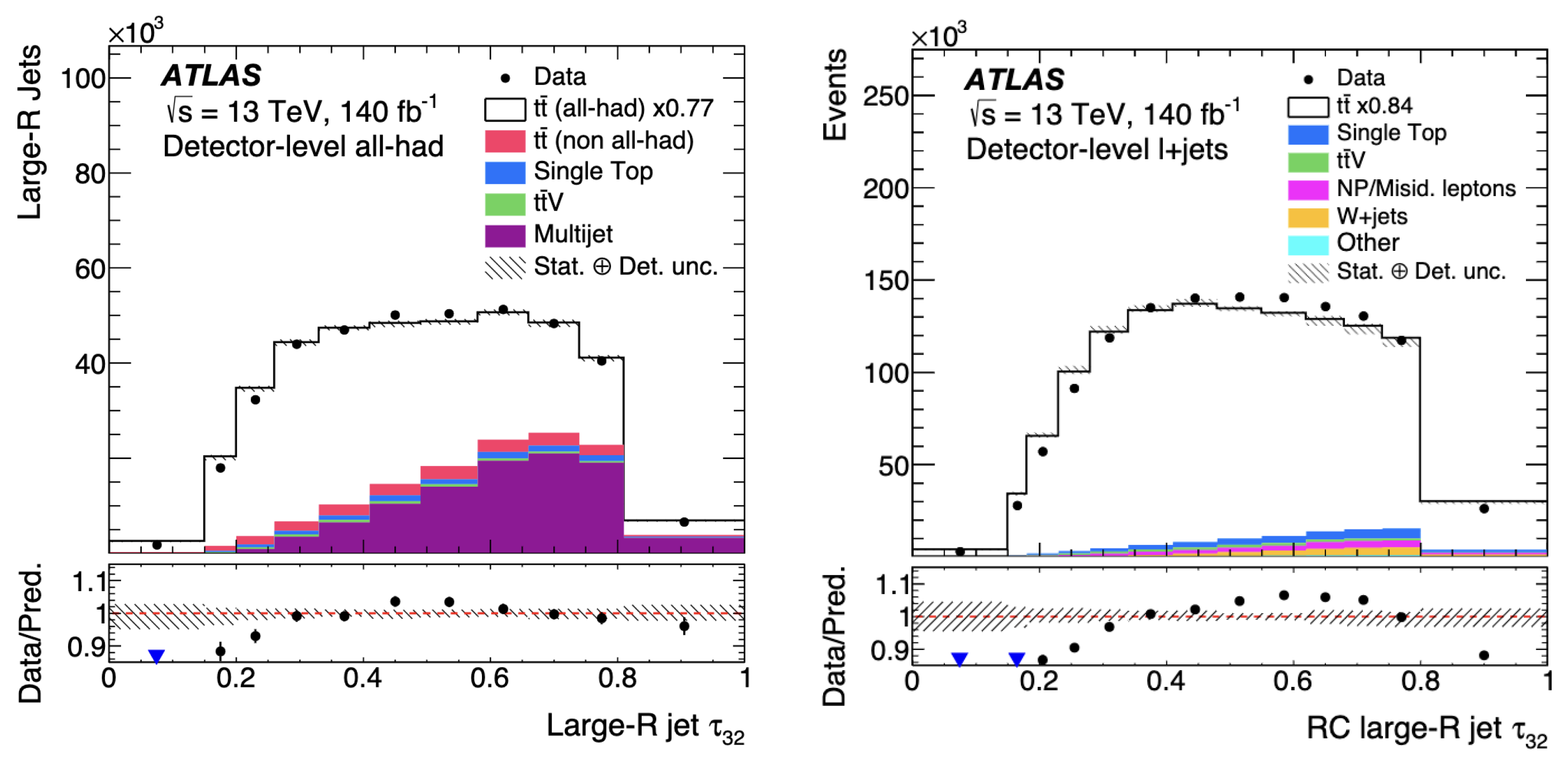
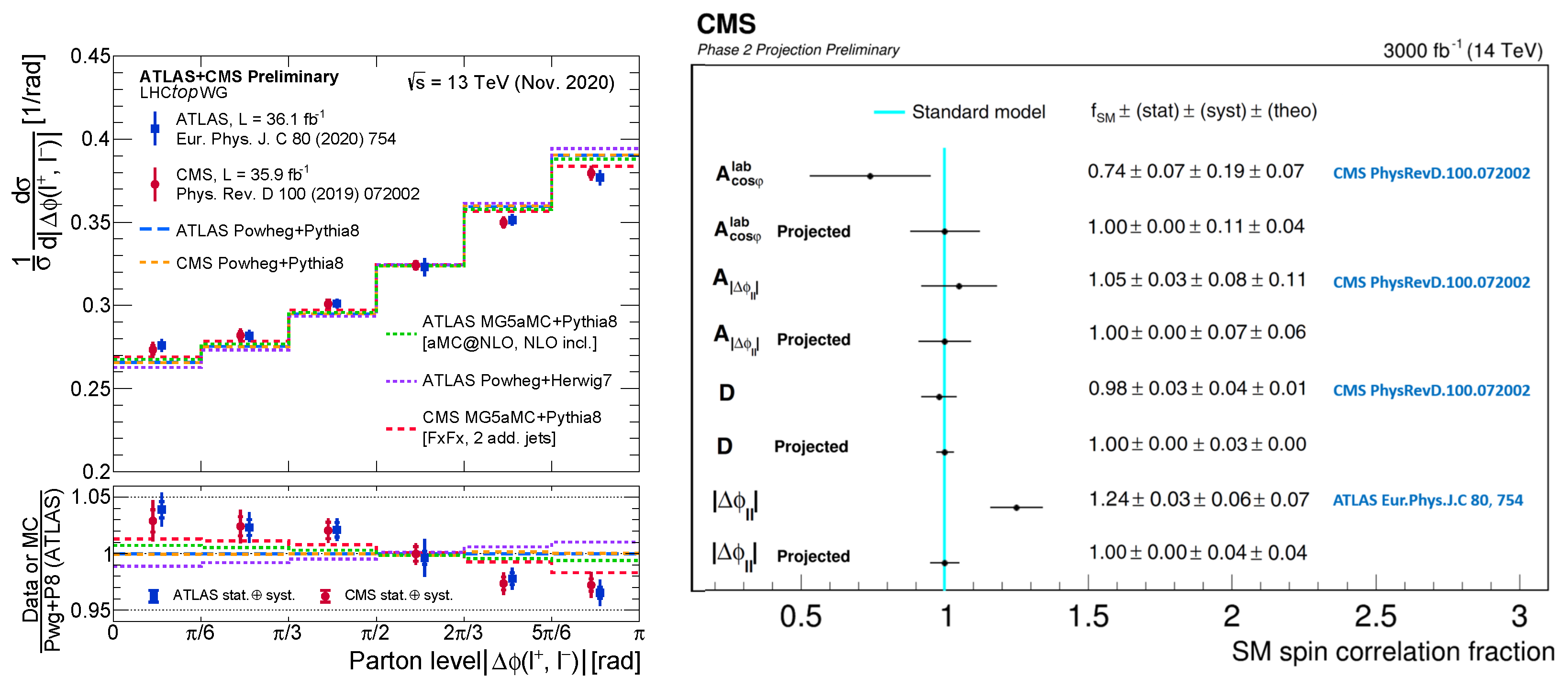
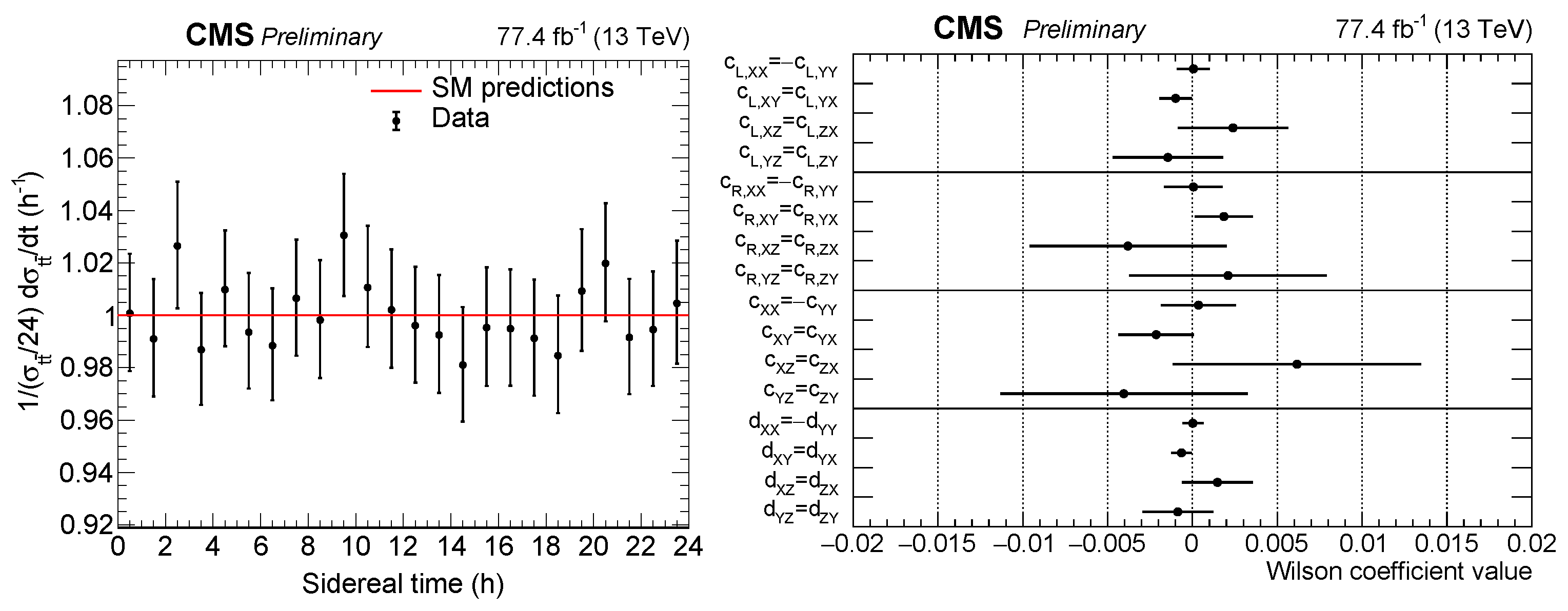

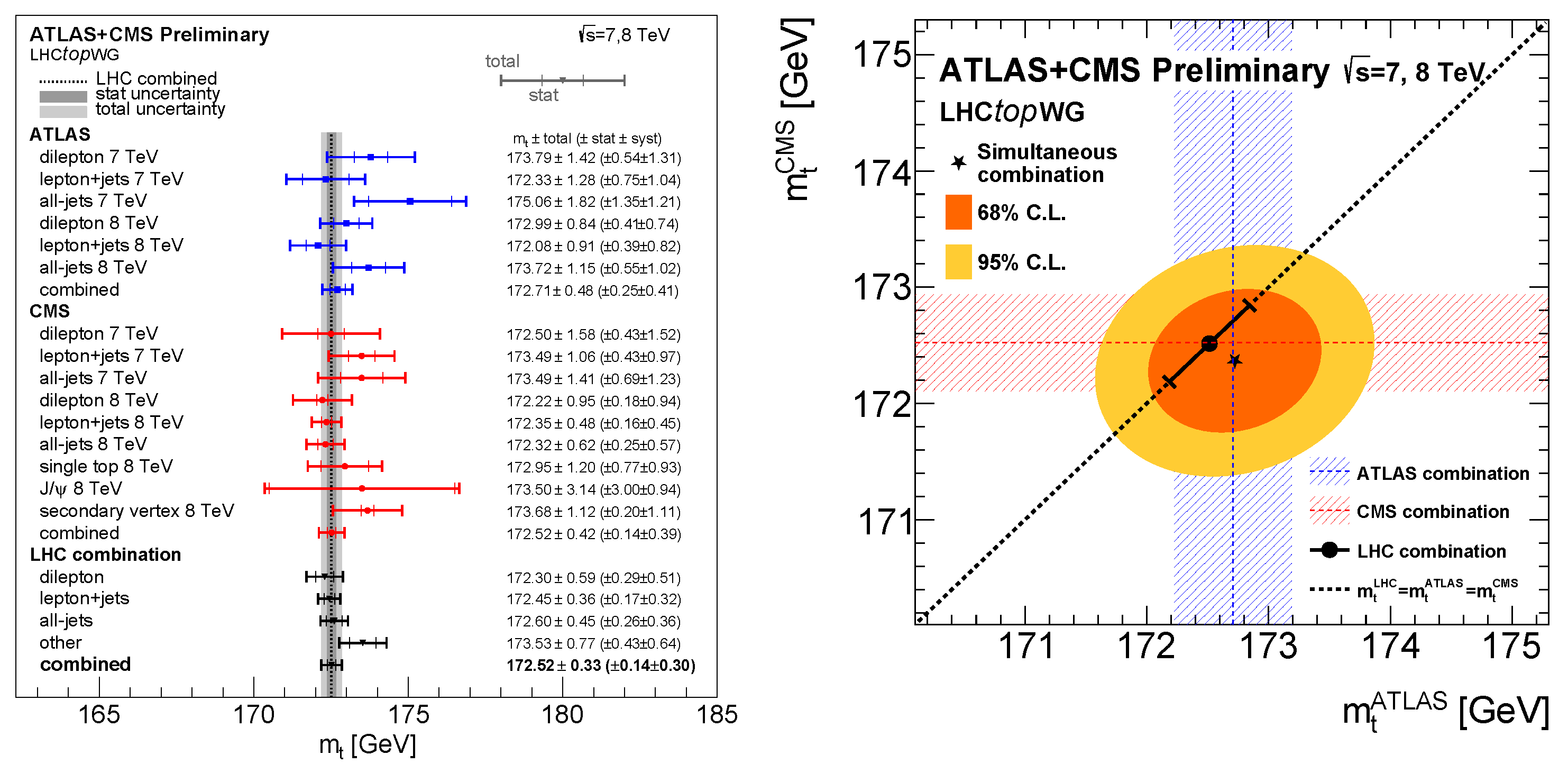


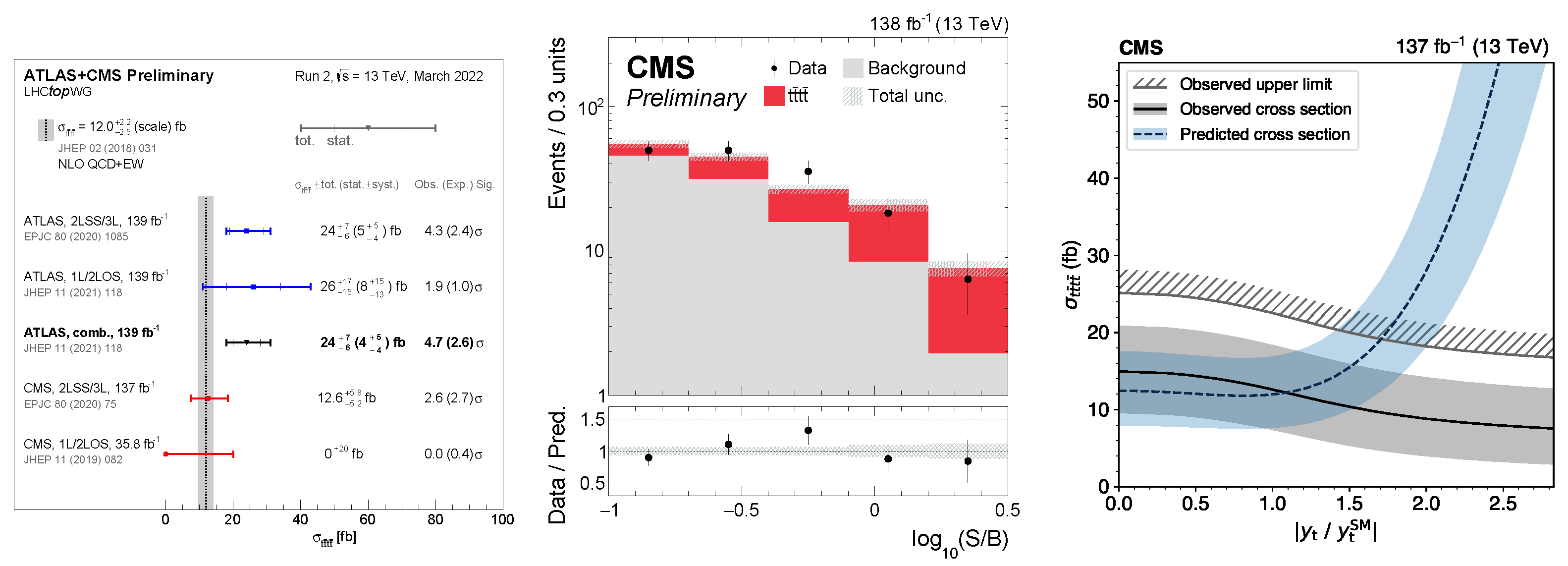
Disclaimer/Publisher’s Note: The statements, opinions and data contained in all publications are solely those of the individual author(s) and contributor(s) and not of MDPI and/or the editor(s). MDPI and/or the editor(s) disclaim responsibility for any injury to people or property resulting from any ideas, methods, instructions or products referred to in the content. |
© 2024 by the author. Licensee MDPI, Basel, Switzerland. This article is an open access article distributed under the terms and conditions of the Creative Commons Attribution (CC BY) license (https://creativecommons.org/licenses/by/4.0/).
Share and Cite
Jung, A. Properties of the Top Quark. Universe 2024, 10, 106. https://doi.org/10.3390/universe10030106
Jung A. Properties of the Top Quark. Universe. 2024; 10(3):106. https://doi.org/10.3390/universe10030106
Chicago/Turabian StyleJung, Andreas. 2024. "Properties of the Top Quark" Universe 10, no. 3: 106. https://doi.org/10.3390/universe10030106




